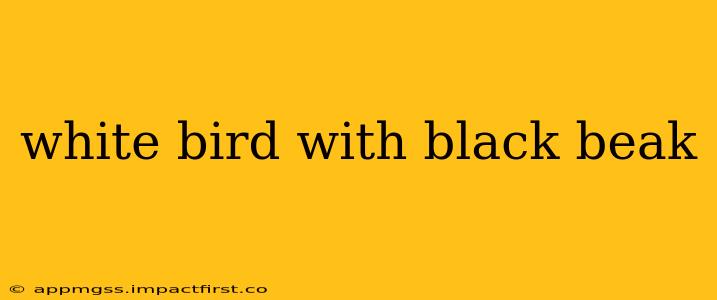White Birds with Black Beaks: A Comprehensive Guide
Many bird species boast striking white plumage contrasted with a sleek black beak. This combination creates a visually appealing and often memorable image. Pinpointing the exact species requires more information, but let's explore some of the most common white birds with black beaks, along with key identifying features to help you narrow down your search.
What are some examples of white birds with black beaks?
This is a broad question, as several bird species share this characteristic. Some prominent examples include:
-
Snowy Egret: A graceful wading bird with pure white plumage, long, black legs, and a long, sharp, black bill. They're often found in wetlands and shallow waters, feeding on fish and other small aquatic creatures. Their size and elegant posture are key identifiers.
-
Great Egret: Larger than the Snowy Egret, the Great Egret also exhibits all-white plumage and a long, black beak. However, its size and longer legs distinguish it from its smaller cousin. They share similar habitats.
-
White Ibis: This bird has a distinctive long, curved, black bill, which it uses to probe in mud and shallow water for food. While primarily white, it might have some darker feathers on its wings or back.
-
Cattle Egret: Mostly white, but with a yellowish tinge to its plumage during breeding season. The beak is typically black, though it might have some yellow at the base in breeding adults. They're often found in fields and pastures, feeding near cattle.
-
Several Gull Species: Some gull species, particularly in their immature stages or during certain times of the year, can appear mostly white with a dark beak. However, gulls are highly variable and require careful observation of size, wing markings, and leg color for precise identification.
What kind of white bird has a long, black beak?
Several species fit this description! The Egrets (Snowy and Great) immediately come to mind due to their remarkably long, slender, and black bills. The White Ibis also has a long, black beak, but it’s curved, unlike the straight beaks of the Egrets. The length of the beak and its shape are crucial in differentiating these species.
Where do white birds with black beaks live?
The habitat varies greatly depending on the species. Egrets, for instance, are often found in wetlands, marshes, and near bodies of water. Ibises prefer similar habitats but are also found in more inland areas. Some gull species are coastal birds, while others are more inland. To determine the habitat, you must know the specific bird.
How can I identify a white bird with a black beak?
Accurate identification requires careful observation of several features beyond just plumage and beak color. Key factors include:
- Size: Compare the bird to familiar objects or other birds in the area to estimate its size.
- Shape and posture: Is the bird slender and elegant (like an egret) or stockier? Does it stand upright or waddle?
- Leg and foot color: Leg and foot color can be highly distinctive.
- Habitat: Where was the bird observed?
- Behavior: What was the bird doing? Was it wading, foraging in the mud, or flying?
- Vocalizations: While not always easy to identify, bird songs can be a helpful clue.
- Detailed photographs: High-quality photographs greatly assist in identification.
Using field guides, online bird identification tools (like Merlin Bird ID), and local birding communities can help you refine your identification.
What is the diet of a white bird with a black beak?
The diet also varies significantly by species. Egrets and ibises are generally carnivorous, feeding on fish, crustaceans, insects, and other small animals. Some gulls are opportunistic feeders, consuming a wider variety of food, including fish, invertebrates, scraps, and even berries.
By carefully observing these details and utilizing available resources, you'll significantly improve your chances of successfully identifying a white bird with a black beak. Remember, birding is a process of observation, learning, and refinement. Happy birding!
